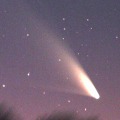
|
Now it is 1.6 mag (Mar. 7, Chris Wyatt). Although it had been brightening as expected until late December, the brightening has got slow down in January. It was expected to be a great comet of -1 mag, but actually, it is fainter than expected. But it is very strongly condensed. It locates extremely low in the evening in the Northern Hemisphere. It is not observable in the Southern Hemisphere for a while after this.
Date(TT) R.A. (2000) Decl. Delta r Elong. m1 Best Time(A, h)
Mar. 9 0 18.02 -8 10.9 1.105 0.304 15 1.3 19:52 ( 78, -4)
Mar. 16 0 34.07 9 29.4 1.148 0.351 17 1.9 19:41 ( 93,-15)
|
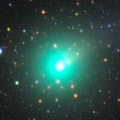
|
Brightened much faster than expected, and it became a naked eye bright comet. Now it is so bright as 4.8 mag (Mar. 7, Marco Goiato). It has a long ion tail. However, the brightness evolution has been slow down in February. It will approach to the sun down to 0.73 A.U. on Mar. 24. It was expected to brighten up to 3 mag, but actually, it will be 4.5 mag at best. It is observable in good condition in the Southern Hemisphere. It is not observable now in the Northern Hemisphere. But it becomes observable again in May, and it keeps observable in good condition after that while fading gradually.
Date(TT) R.A. (2000) Decl. Delta r Elong. m1 Best Time(A, h)
Mar. 9 0 7.98 -41 27.7 1.274 0.794 38 4.7 19:52 ( 49, 14)
Mar. 16 0 9.35 -33 42.3 1.367 0.751 32 4.6 19:41 ( 54, 6)
|

|
It brightened up to 9.0 mag in 2012 autumn (Nov. 4, Juan Jose Gonzalez). Appearing in the morning sky in the Southern Hemisphere. It keeps observable in good condition while fading slowly after this. However, Michael Mattiazzo reported that it was fainter than 12 mag on Feb. 2, much fainter than predicted. In the Northern Hemisphere, it is hardly observable after 2013.
Date(TT) R.A. (2000) Decl. Delta r Elong. m1 Best Time(A, h)
Mar. 9 21 46.93 -41 44.7 2.589 1.971 42 9.3 4:27 (307, 20)
Mar. 16 22 11.94 -42 20.0 2.577 2.007 45 9.4 4:34 (307, 22)
|
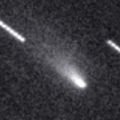
|
Got brighter than expected after the outburst on Jan. 24. It brightened up to 9.2 mag on Feb. 4 (Michael Mattiazzo). However, it suddenly faded down to 10.5 mag and got diffuse on Feb. 5 (Michael Mattiazzo). It approached to the Sun down to 0.3 A.U. on Feb. 24. In the Northern Hemisphere, it is appearing in the morning sky. Now it is 13.5 mag (Mar. 8, Juro Kobayashi), much fainter than this ephemeris. Because the comet is small, it can fade out very quickly. In the Southern Hemisphere, it locates extremely low in early March. But it will be unobservable after that.
Date(TT) R.A. (2000) Decl. Delta r Elong. m1 Best Time(A, h)
Mar. 9 21 22.42 -0 42.8 0.985 0.494 28 9.4 4:27 (269, 3)
Mar. 16 21 28.78 11 29.8 1.073 0.642 35 10.7 4:34 (255, 2)
|
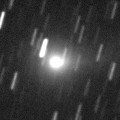
|
Long-lost comet for almost 200 years since 1827. Finally re-discovered by Rob Matson from SWAN images of mid November. Now it is 11.3 mag (Mar. 5, Jakub Cerny). In the Northern Hemisphere, it keeps observable in excellent condition while fading after this. In the Southern Hemisphere, it is only observable in low sky from February to March.
Date(TT) R.A. (2000) Decl. Delta r Elong. m1 Best Time(A, h)
Mar. 9 17 29.32 32 39.8 1.251 1.596 89 11.3 4:27 (205, 17)
Mar. 16 17 0.91 39 38.0 1.214 1.689 99 11.7 4:34 (191, 15)
|
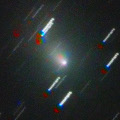
|
Now it is so bright as 11.1 mag (Mar. 9, Carlos Labordena). In the Northern Hemisphere, it keeps observable in good condition until April. It is not observable now in the Southern Hemisphere. It will become observable after April, but it keeps locating low.
Date(TT) R.A. (2000) Decl. Delta r Elong. m1 Best Time(A, h)
Mar. 9 3 3.96 31 48.3 1.899 1.730 64 12.3 19:52 (133, 3)
Mar. 16 3 19.85 28 36.0 1.944 1.686 60 12.2 19:41 (131, 5)
|
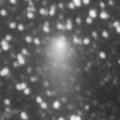
|
Now it is bright as 12.3 mag (Mar. 9, Marco Goiato). It is expected to be observable at 11-13 mag for a long time from 2012 summer to 2013 summer.
Date(TT) R.A. (2000) Decl. Delta r Elong. m1 Best Time(A, h)
Mar. 9 15 57.63 -16 0.4 2.169 2.646 107 12.4 4:27 (197, 70)
Mar. 16 15 49.22 -12 58.8 2.092 2.695 117 12.4 4:16 (180, 68)
|

|
It brightened up to 11-12 mag in 2012. Now it is 13.3 mag (Feb. 2, Jakub Cerny). It will be observable at 12-13 mag in good condition again in 2013.
Date(TT) R.A. (2000) Decl. Delta r Elong. m1 Best Time(A, h)
Mar. 9 15 13.13 -17 0.7 5.158 5.691 117 12.9 4:07 (180, 72)
Mar. 16 15 7.02 -16 46.6 5.068 5.714 126 12.9 3:33 (180, 72)
|

|
It brightened rapidly, and reached up to 12 mag in 2012. Appearing in the mornig sky again. It will be observable at 12-14 mag in good condition again in 2013. However, it locates somewhat low in the Northern Hemisphere in 2013. By the way, Juan Jose Gonzalez reported it is extremely bright as 9.6 mag on Jan. 20.
Date(TT) R.A. (2000) Decl. Delta r Elong. m1 Best Time(A, h)
Mar. 9 18 53.09 -24 11.2 3.140 2.888 66 13.5 4:27 (270, 46)
Mar. 16 19 2.82 -24 25.0 3.055 2.891 71 13.4 4:34 (266, 51)
|

|
Carlos Labordena reported it is extremely bright as 11.4 mag on Feb. 6. However, it is extremely diffuse.
Date(TT) R.A. (2000) Decl. Delta r Elong. m1 Best Time(A, h)
Mar. 9 14 10.01 -24 5.4 5.553 6.227 129 13.7 3:04 (180, 79)
Mar. 16 14 8.26 -24 7.7 5.470 6.226 136 13.6 2:35 (180, 79)
|
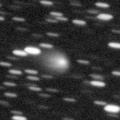
|
Now it is 13.7 mag (Jan. 11, Hiroshi Abe). It keeps bright at 13-14 mag for a long time until 2014. It keeps observable for a long time in the Northern Hemisphere. It is not observable in the Southern Hemisphere.
Date(TT) R.A. (2000) Decl. Delta r Elong. m1 Best Time(A, h)
Mar. 9 21 13.92 29 37.5 6.579 5.922 45 13.7 4:27 (243,-13)
Mar. 16 21 15.89 29 46.7 6.548 5.918 47 13.7 4:34 (238, -7)
|

|
Now it is so bright as 11.8 mag (Mar. 9, Carlos Labordena). In the Northern Hemisphere, it keeps observable in excellent condition. In the Southern Hemisphere, it keeps locating extremely low for a while.
Date(TT) R.A. (2000) Decl. Delta r Elong. m1 Best Time(A, h)
Mar. 9 9 47.12 30 18.2 1.071 1.977 146 14.0 22:37 (180, 25)
Mar. 16 9 42.78 28 17.2 1.092 1.967 140 14.0 22:06 (180, 27)
|

|
It kept as bright as 6-7 mag for a long time from 2011 summer to 2012 spring. Now it is fading. But it is bright as 15.2 mag still now (Mar. 4, Sandor Szabo).
Date(TT) R.A. (2000) Decl. Delta r Elong. m1 Best Time(A, h)
Mar. 9 8 25.40 -9 49.7 4.516 5.263 134 14.0 21:16 (180, 65)
Mar. 16 8 20.61 -9 27.3 4.651 5.325 128 14.2 20:44 (180, 64)
|
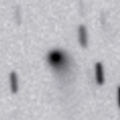
|
It is expected to keep 13 mag and observable in good condition in the Northern Hemisphere for a long time from 2013 to 2014. Now it is 14.5 mag (Mar. 4, Sandor Szabo). It will be observable also in the Southern Hemisphere from early December to early March, although it locates low.
Date(TT) R.A. (2000) Decl. Delta r Elong. m1 Best Time(A, h)
Mar. 9 10 17.64 45 18.3 3.558 4.340 137 14.1 23:07 (180, 10)
Mar. 16 10 5.69 46 39.0 3.591 4.303 130 14.1 22:28 (180, 8)
|

|
Big asteroid discovered in 1906. It suddenly showed the cometary activity on Dec. 11, 2010, probably due to an impact of a small object. Now it is 11.9 mag (May 29, Marco Goiato). It has already turned to be stellar. It is not observable now.
Date(TT) R.A. (2000) Decl. Delta r Elong. m1 Best Time(A, h)
Mar. 9 22 18.78 -21 40.0 3.629 2.736 22 14.4 4:27 (294, 4)
Mar. 16 22 30.78 -20 46.1 3.608 2.747 25 14.5 4:34 (290, 7)
|
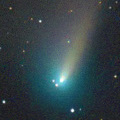
|
It approached to the earth down to 0.3 A.U. and brightened up to 7-8 mag from late December to early January. However, it will go away from the earth and fade out rapidly after this. It has already faded down to 13.8 mag (Feb. 28, Sandor Szabo). It is observable in good condition also in the Southern Hemisphere after this.
Date(TT) R.A. (2000) Decl. Delta r Elong. m1 Best Time(A, h)
Mar. 9 4 17.36 -16 51.8 1.915 1.904 74 14.5 19:52 (106, 49)
Mar. 16 4 22.80 -17 17.1 2.083 1.983 70 15.0 19:41 (103, 47)
|

|
Now it is 14.7 mag (Feb. 3, Jakub Cerny). It will be fading slowly after this. But it keeps 15 mag in 2013. It is observable in good condition in the Southern Hemisphere. It is not observable now in the Northern Hemisphere.
Date(TT) R.A. (2000) Decl. Delta r Elong. m1 Best Time(A, h)
Mar. 9 3 2.67 -35 54.3 6.731 6.299 60 14.6 19:52 ( 71, 42)
Mar. 16 3 5.44 -34 36.2 6.806 6.324 57 14.7 19:41 ( 71, 39)
|

|
Now it is bright and visible visually at 12.9 mag (Jan. 3, Chris Wyatt). It keeps 12-14 mag until February. It keeps observable in good condition in the Northern Hemisphere. It is not observable now in the Southern Hemisphere.
Date(TT) R.A. (2000) Decl. Delta r Elong. m1 Best Time(A, h)
Mar. 9 1 59.77 17 29.3 3.895 3.281 45 14.9 19:52 (113, 2)
Mar. 16 2 10.50 17 32.7 3.983 3.299 41 15.0 19:41 (112, 0)
|
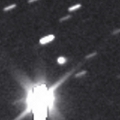
|
Now it is 14.9 mag (Mar. 4, Jakub Cerny). Already visible visually. It is expected to be a great comet in 2013 autumn when the comet approaches to the sun down to only 0.01 A.U. It keeps visible with naked eyes from November to January, and can be extremely bright as Venus or more at the highlight. The condition is excellent in the Northern Hemisphere. It keeps observable almost all through the period of brightening, at the highlight, and of fading. The condition is not good in the Southern Hemisphere. It is not observable at all the latter part of the highlight, and it keeps low all through the period.
Date(TT) R.A. (2000) Decl. Delta r Elong. m1 Best Time(A, h)
Mar. 9 6 45.68 31 20.7 4.071 4.525 111 15.1 19:52 (176, 24)
Mar. 16 6 42.11 31 8.0 4.105 4.445 103 15.0 19:41 (172, 23)
|

|
Now it is 16.3 mag (Feb. 10, Hiroshi Abe). It keeps bright as 13-14 mag for a long time from 2013 to 2014.
Date(TT) R.A. (2000) Decl. Delta r Elong. m1 Best Time(A, h)
Mar. 9 14 52.38 -11 10.7 2.888 3.543 124 15.2 3:46 (180, 66)
Mar. 16 14 51.92 -11 10.5 2.792 3.528 131 15.1 3:18 (180, 66)
|
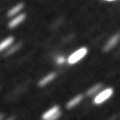
|
Now it is 15.6 mag (Jan. 23, W. Hasubick). It will brighten up to 12 mag from summer to autumn in 2013. In the Northern Hemisphere, it is observable only until spring when the comet brightens up to 15 mag. In the Southern Hemisphere, it keeps unobservable until August. Then it keeps observable while fading gradually.
Date(TT) R.A. (2000) Decl. Delta r Elong. m1 Best Time(A, h)
Mar. 9 1 19.28 46 27.6 2.977 2.587 57 15.5 19:52 (132,-22)
Mar. 16 1 36.59 45 24.0 2.978 2.517 53 15.4 19:41 (131,-21)
|

|
Now it is 15.8 mag, brighter than expected (Feb. 4, Hidetaka Sato). It reaches up to 15 mag from spring to summer. It is observable in excellent condition in the Southern Hemisphere. It locates low in the Northern Hemisphere.
Date(TT) R.A. (2000) Decl. Delta r Elong. m1 Best Time(A, h)
Mar. 9 16 32.84 -49 31.3 3.213 3.423 93 15.6 4:27 (328, 72)
Mar. 16 16 22.93 -49 24.9 3.071 3.411 101 15.4 4:34 (350, 75)
|
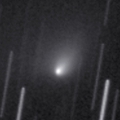
|
Now it is visible visually at 13.7 mag (Dec. 23, Juan Jose Gonzalez). It keeps 15 mag until March. In the Northern Hemisphere, it keeps observable for a long time until the comet fades out. It is not observable in the Southern Hemisphere, except for 2013 spring, but the comet locates extremely low only.
Date(TT) R.A. (2000) Decl. Delta r Elong. m1 Best Time(A, h)
Mar. 9 4 12.00 32 13.4 2.400 2.412 78 15.7 19:52 (144, 12)
Mar. 16 4 19.83 29 36.4 2.539 2.440 72 15.9 19:41 (141, 13)
|
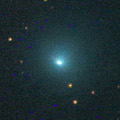
|
First return of a new periodic comet discovered in 1994. It brightened rapidly and reached up to 10.6 mag (Dec. 13, Katsumi Yoshimoto). Now it is fading. It has already faded down to 14.6 mag (Mar. 4, Sandor Szabo). It has a large diffuse coma. It keeps locating high for a while, but it will be fading after this.
Date(TT) R.A. (2000) Decl. Delta r Elong. m1 Best Time(A, h)
Mar. 9 4 6.96 -3 50.8 1.818 1.785 72 15.8 19:52 (118, 39)
Mar. 16 4 24.70 -3 10.1 1.925 1.846 70 16.3 19:41 (119, 39)
|
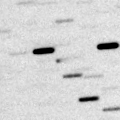
|
Now it is 16.2 mag (Feb. 16, Ken-ichi Kadota). It keeps observable at 16 mag in the morning sky from February to April.
Date(TT) R.A. (2000) Decl. Delta r Elong. m1 Best Time(A, h)
Mar. 9 19 13.56 -13 41.8 1.757 1.538 60 15.9 4:27 (261, 36)
Mar. 16 19 33.65 -12 55.9 1.729 1.549 62 15.9 4:34 (258, 39)
|
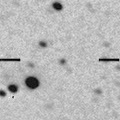
|
Now it is 16.4 mag (Jan. 6, J. F. Hernandez). It is expected to brighten up to 5-6 mag in 2014 autumn. In 2013, it keeps observable in good condition until autumn when it brigthens up to 13-14 mag.
Date(TT) R.A. (2000) Decl. Delta r Elong. m1 Best Time(A, h)
Mar. 9 17 33.56 12 8.1 6.354 6.380 87 16.1 4:27 (217, 35)
Mar. 16 17 33.22 12 52.5 6.191 6.318 92 16.0 4:34 (207, 38)
|

|
Now it is 16.1 mag (Jan. 16, Jakub Cerny). In the Southern Hemisphere, it will be observable at 15-16 mag in good condition for a long time until summer. It is not observable at all in the Northern Hemisphere.
Date(TT) R.A. (2000) Decl. Delta r Elong. m1 Best Time(A, h)
Mar. 9 2 9.80 -59 36.3 4.605 4.266 64 16.1 19:52 ( 38, 38)
Mar. 16 2 23.58 -57 53.6 4.627 4.290 64 16.2 19:41 ( 40, 38)
|

|
Now it is 16.4 mag (Jan. 18, Yasukazu Ikari). It will be observable at 17 mag for a long time from 2013 to 2014.
Date(TT) R.A. (2000) Decl. Delta r Elong. m1 Best Time(A, h)
Mar. 9 12 12.81 5 33.0 2.930 3.901 166 16.5 1:07 (180, 50)
Mar. 16 12 9.16 5 49.8 2.905 3.893 172 16.5 0:36 (180, 49)
|
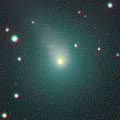
|
It brightened much faster than expected, and reached up to 10.0 mag in summer (Aug. 9, Juan Jose Gonzalez). Now it is fading, but it is bright as 13.3 ma still now (Feb. 2, Hidetaka Sato). It keeps observable in good condition for a while after this.
Date(TT) R.A. (2000) Decl. Delta r Elong. m1 Best Time(A, h)
Mar. 9 6 36.55 4 34.9 2.876 3.349 110 16.6 19:52 (170, 50)
Mar. 16 6 33.79 3 58.1 3.044 3.405 102 16.9 19:41 (163, 50)
|

|
It was discovered at 15 mag in late December. It must have been bright as 13-14 mag and observable in good condition from spring to autumn in the Southern Hemisphere. But it was not discovered. Now it is fading. It has already faded down to 16.6 mag (Mar. 4, Hidetaka Sato). It will be fainter than 18 mag in April, and keeps observable in good condition. It will be observable also in the Northern Hemisphere after this in the evening sky while fading gradually.
Date(TT) R.A. (2000) Decl. Delta r Elong. m1 Best Time(A, h)
Mar. 9 5 26.29 -23 18.0 2.727 2.906 90 16.8 19:52 (114, 66)
Mar. 16 5 31.56 -20 17.3 2.853 2.966 86 17.0 19:41 (116, 62)
|

|
Not observed yet in this apparition. But it must have already brightened up to 17 mag. It will brighten up to 14 mag and will be observable in excellent condition in summer.
Date(TT) R.A. (2000) Decl. Delta r Elong. m1 Best Time(A, h)
Mar. 9 15 8.98 -1 32.6 1.500 2.192 121 17.2 4:02 (180, 57)
Mar. 16 15 14.09 -1 2.8 1.401 2.153 127 16.9 3:40 (180, 56)
|
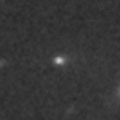
|
Now it is 16.2 mag (Feb. 18, Mt. Lemmon Survey). It keeps observable in good condition at 17 mag from January to June. It locates somewhat low in the Southern Hemisphere.
Date(TT) R.A. (2000) Decl. Delta r Elong. m1 Best Time(A, h)
Mar. 9 8 54.82 21 55.2 1.166 2.039 141 16.9 21:46 (180, 33)
Mar. 16 8 54.48 22 15.3 1.199 2.023 134 17.0 21:18 (180, 33)
|

|
It is expected to brighten up to 11 mag and become observable in excellent condition in 2014 spring. Now it is 17.0 mag (Feb. 18, Catalina Sky Survey). In the Northern Hemisphere, it keeps observable in good condition until early summer. It locates low in the Southern Hemisphere.
Date(TT) R.A. (2000) Decl. Delta r Elong. m1 Best Time(A, h)
Mar. 9 8 44.20 40 20.8 3.678 4.388 130 17.3 21:35 (180, 15)
Mar. 16 8 39.90 40 39.8 3.696 4.323 123 17.2 21:03 (180, 14)
|
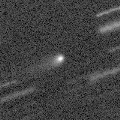
|
Now it is 17.3 mag (Feb. 19, K. Hills). It brightened up to 16.5 mag in 2012. It will be observable in good condition again at 17.5 mag in 2013 spring.
Date(TT) R.A. (2000) Decl. Delta r Elong. m1 Best Time(A, h)
Mar. 9 13 48.03 5 27.5 5.192 6.010 142 17.4 2:42 (180, 50)
Mar. 16 13 40.96 6 6.3 5.143 6.028 150 17.4 2:08 (180, 49)
|
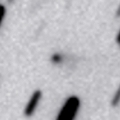
|
It was identified with an old comet discovered in 1931 by Tombaugh. It was unusually bright as 12.5 mag in 1931. Now it is 16.9 mag (Feb. 8, Toshiyuki Takahashi). It keeps 17.5 mag until March, and keeps observable in excellent condition in the Northern Hemisphere. It locates low in the Southern Hemisphere.
Date(TT) R.A. (2000) Decl. Delta r Elong. m1 Best Time(A, h)
Mar. 9 6 50.60 36 44.8 1.901 2.444 111 17.8 19:52 (178, 18)
Mar. 16 6 56.66 36 37.3 1.981 2.447 105 17.9 19:41 (176, 18)
|

|
It was observed around 20 mag in 2012 spring. But it has not been observed recently. It will be observable at 17.5 mag from spring to summer.
Date(TT) R.A. (2000) Decl. Delta r Elong. m1 Best Time(A, h)
Mar. 9 17 45.80 -24 12.3 2.570 2.617 81 17.9 4:27 (258, 60)
Mar. 16 17 54.86 -23 47.3 2.482 2.618 86 17.8 4:34 (251, 64)
|
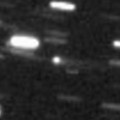
|
Now it is 17.7 mag (Jan. 11, V. Gerke, S. Plaksa, A. Novichonok). It reached up to 17 mag in last winter between 2011 and 2012. It will be observable in good condition again at 17.5 mag in this winter.
Date(TT) R.A. (2000) Decl. Delta r Elong. m1 Best Time(A, h)
Mar. 9 9 7.07 18 8.2 3.360 4.215 145 17.9 21:58 (180, 37)
Mar. 16 9 4.71 18 14.4 3.434 4.224 137 17.9 21:28 (180, 37)
|
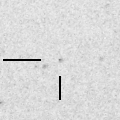
|
Now it is 17.9 mag (Feb. 10, Hidetaka Sato). It keeps observable in good condition at 17 mag from spring to summer.
Date(TT) R.A. (2000) Decl. Delta r Elong. m1 Best Time(A, h)
Mar. 9 18 5.14 -17 19.3 2.960 2.907 77 18.0 4:27 (252, 52)
Mar. 16 18 13.81 -16 41.7 2.867 2.903 82 17.9 4:34 (245, 57)
|

|
First return of a new periodic comet discovered in 2005. It will be observable at 17 mag for a long time from 2013 to 2014. However, it has not been recovered yet. Not it is fainter than 19.5 mag (Feb. 21, Martin Masek).
Date(TT) R.A. (2000) Decl. Delta r Elong. m1 Best Time(A, h)
Mar. 9 17 7.74 -14 52.9 3.182 3.352 91 18.0 4:27 (232, 61)
Mar. 16 17 12.58 -14 45.6 3.074 3.343 96 17.9 4:34 (220, 65)
|
|
![]()
 C/2012 L1 ( LINEAR )
C/2012 L1 ( LINEAR ) 262P/2012 K7 ( McNaught-Russell )
262P/2012 K7 ( McNaught-Russell ) 125P/Spacewatch
125P/Spacewatch C/2012 K1 ( PanSTARRS )
C/2012 K1 ( PanSTARRS ) C/2011 O1 ( LINEAR )
C/2011 O1 ( LINEAR ) P/2012 B1 ( PanSTARRS )
P/2012 B1 ( PanSTARRS ) C/2011 UF305 ( LINEAR )
C/2011 UF305 ( LINEAR ) C/2012 Y3 ( McNaught )
C/2012 Y3 ( McNaught ) 98P/Takamizawa
98P/Takamizawa 175P/Hergenrother
175P/Hergenrother C/2012 X1 ( LINEAR )
C/2012 X1 ( LINEAR ) C/2010 R1 ( LINEAR )
C/2010 R1 ( LINEAR ) 274P/2012 WX32 ( Tombaugh-Tenagra )
274P/2012 WX32 ( Tombaugh-Tenagra ) 91P/Russell 3
91P/Russell 3 244P/2010 Q1 ( Scotti )
244P/2010 Q1 ( Scotti ) P/2012 F2 ( PanSTARRS )
P/2012 F2 ( PanSTARRS ) P/2005 L1 ( McNaught )
P/2005 L1 ( McNaught )![]()

































